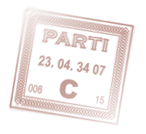




The Volto Santo in Lucca
The “Volto Santo” (Holy Face) is kept in the splendid Romanic cathedral of San Martino, in Lucca: a wooden work of uncertain origin depicting the crucified Christ. Every year, the 13th September the procession and “Luminara” is dedicated to the Volto Santo, an object of veneration and adoration since medieval times, and the next day religious and lay celebrations take place. The procession winds along Lucca’s ways during the transposition of the Volto Santo: from San Martino’s Cathedral to San Frediano's church.
Various legends have blossomed around the Crucifix, given its uncertain origin.






According the most credited one, represented also through a cycle of frescoes inside San Frediano’s church, the Crucifix was sculpted in Jerusalem by Jesus’ disciple: Nicodemus.
He, guided by an angel, started the depiction on Lebanon’s citrus wood, but when he arrived at the delineation of the face, he was seized by the fear of not portraying it faithfully. Thus upon awaking, after a long dream, he saw the face, delicately sculpted, and the work miraculously completed.
Upon Nicodemus’ death, the Volto Santo was entrusted to Isaccar who, fearing prosecution from Hebrews, hid the sacred image in a cave, where it remained until some centuries later when Bishop Gualfredo, on pilgrimage to the Holy Land, through a revelatory dream, discovered where the sacred sculpture was hidden.
It is told that Bishop Gualfredo tried to get it to Italy on a boat without a crew, entrusting the Sacro Volto to divine guidance; and thus it was that the boat arrived at the Luni harbour, in current Tuscany. The ancient Luni tried more than once to climb on board without succeeding in the intent since, every time they tried to board the boat, as if driven by the wind, it got slightly further from the shore.
Only the Bishop of Lucca, who was also guided by a revelatory dream, succeeded in boarding the small boat thus recovering the sacred image. And in order to decide which of the two cities the property of the wooden sculpture belonged to, the Bishop proposed for the decision to be entrusted to Divine Will once more. The Holy Cross was placed in a cart pulled by oxen free of reins: if they headed for Lucca, the wooden sculpture would have been of the potently walled city, otherwise the Luni people would have gained possession of it.
So it was that the image was brought with jubilation into the city, in San Frediano’s church. However, next morning, the Volto Santo had disappeared from the church and was found in San Martino’s church. The transposition was interpreted as a miracle and it was therefore decided to build a cathedral to venerate the Volto Santo.


The modern aspect of the Parish Church of Codiponte, dedicated to the Saints Cornelio and Cipriano, is due to the restoration that took place during the XIX century, which eliminated the traces of decorations made after the Romanesque period.
The Parish Church, probably, stands on a roman village, which was important on the Luni-Lucca route. The most interesting part of the church is the sculptural decoration on the capitals, typical of the Lombard and Carolingian Ages.
Together with this wonderful decoration, we find also typical elements of the romanesque style.



The Pieve of Pognana it is found along the left side of the Rosaro torrent where one can enjoy a splendid natural scenery and the view of the Verrucola castle.
This church was probably built on top of a small chapel, that is today the foundations of the bell tower in Romanesque style with an apse completely inserted in the masonry.
The inner space is subdivided in three naves, separated by imposing columns. The central and left naves end in semicircular apses characterized from hanging bows and columns in that greater nave.



Along the state road 63 that leads to the Cerreto crossing, not far away from the pieve of Offiano and along varying of the Francigena route, is the Church of Saint Paul.
Over time this church has been subject to many renovations, the two lateral apses were added and the stone facade reconstructed. Its central nave is higher than the side naves window to cross and a double lancet window over to the portal. The main apse is characterized in the high part from hanging bows with figured consoles. Its shape and the limestone it is built with, testifies the Lombard and Tuscan influences.




